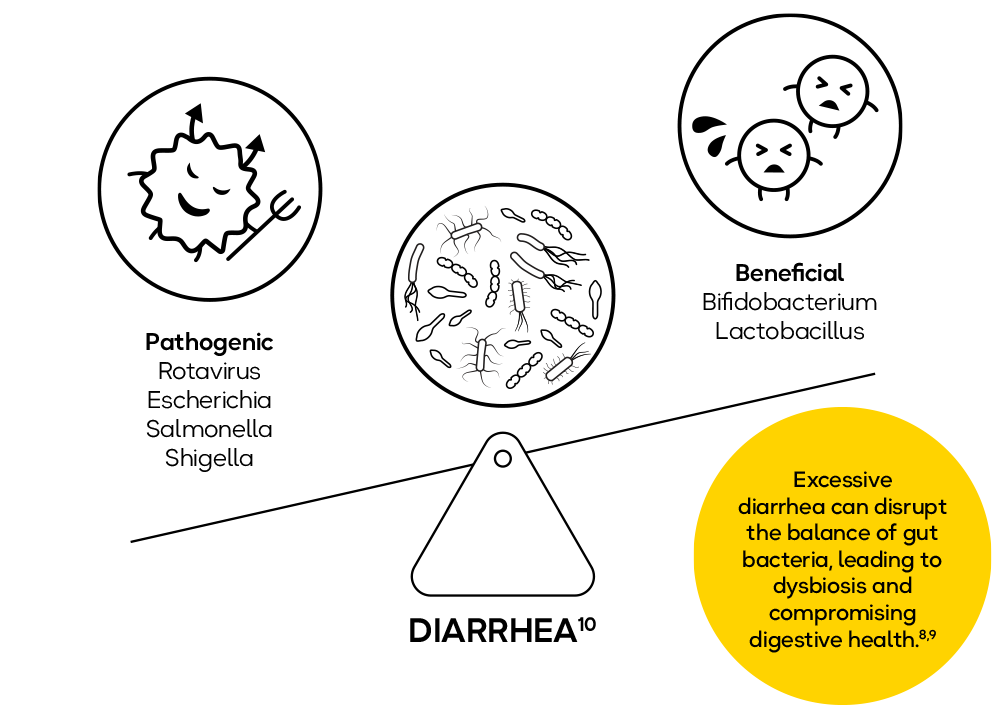When diarrhea strikes,
it can turn a child’s
world upside down.
A comprehensive approach is vital to restoring their health and reducing the duration of diarrheal episodes in children.
When diarrhea strikes, it can turn a child’s world upside down.
A comprehensive approach is vital to restoring their health and reducing the duration of diarrheal episodes in children.
Understand the Global Challenge of Diarrhea in Children
Diarrhea is usually a symptom of an infection in the intestinal tract caused by a variety of enteropathogens.1
Infant Diarrhea
Accounted for around 9% of mortality in children aged under 5 years globally in 20212
Third-leading cause of mortality, killing 1200 children every day2,3
Nearly 1.7 billion cases every year1
Mainly caused by Salmonella spp, Rotavirus, and Shigella spp 2,4
Diarrhea remains the leading cause of child mortality and morbidity in the world, while it is both preventable and treatable.1
So,
What Does Diarrhea
Actually Do?
So,
What Does Diarrhea
Actually Do?
Long-Term Consequences of Chronic Diarrhea
Recurrent infections
Susceptible to infections and inflammatory conditions later in life
Metabolic imbalances
Can lead to long-term health issues
Hindered growth
Growth development may be delayed
Psychological imbalance
Emotional well-being may be affected

BioGaia Protectis Powder
Suitable for 0-18 years old and adults
Recommended dose: 1 sachet a day
- Do not require refrigeration
- Treatment for acute diarrhea (2 sachets a day)
- Other indications include colic, regurgitation, constipation
and other gastro intestinal disorder
It’s easy to add to meal.
Protectis Powder methods of preparation:
- Pour powder to milk bottle and shake to mix (volume in accordance to baby ‘s ability to finish)
- Mix and stir with drink (30 – 35°C)
- Stir in a bowl (like porridge/rice etc)
- Pour directly into mouth
- Add to liquid drink/juice (below 35°C)

Stay healthy throughout life with BioGaia
WHO. Diarrheal disease. 2017. Available at: https://www.who.int/news-room/fact-sheets/detail/diarrheal-disease. Accessed on: 16 January 2024. 2. Diarrhea. UNICEF. 2024. Available at: https://www.who.int/news-room/fact-sheets/detail/diarrhoeal-disease. Accessed on: 25 March 2024. 3. Diarrhoeal disease. WHO. 2024. Available at: https://www.who.int/news-room/fact-sheets/detail/diarrhoeal-disease. Accessed on: 25 March 2024. 4. Nemeth V, Pfleghaar N. Diarrhea. In: StatPearls. Treasure Island (FL): StatPearls Publishing, 2023. Available at: http://www.ncbi.nlm.nih.gov/books/NBK448082/. Accessed on: 12 February 2024. 5. Diarrhea. UNICEF and WHO. 2024. Available at: https://www.who.int/publications/i/item/WHO_FCH_CAH_04.7. Accessed on: 16 January 2024. 6. Diarrheal disease. WHO. 2017. Available at: https://www.who.int/news-room/fact-sheets/detail/diarrheal-disease. Accessed on: 16 January 2024. 7. Bartelt LA, et al. PLoS Negl Trop Dis. 2013;7(4):e2125. 8. Fan Q, et al. Can J Infect Dis Med Microbiol. 2020;2020:8837156. 9. Li Y, et al. Front Cell Infect Microbiol. 2021;11:625210. 10. Diarrhoeal disease. WHO. 2024. Available at: https://www.who.int/news-room/fact-sheets/detail/diarrhoeal-disease. Accessed on: 25 May 2024. 11. The HC, Le SH. Curr Opin Microbiol. 2WHO. Diarrheal disease. 2017. Available at: https://www.who.int/news-room/fact-sheets/detail/diarrheal-disease. Accessed on: 16 January 2024. 2. Diarrhea. UNICEF. 2024. Available at: https://www.who.int/news-room/fact-sheets/detail/diarrhoeal-disease. Accessed on: 25 March 2024. 3. Diarrhoeal disease. WHO. 2024. Available at: https://www.who.int/news-room/fact-sheets/detail/diarrhoeal-disease. Accessed on: 25 March 2024. 4. Nemeth V, Pfleghaar N. Diarrhea. In: StatPearls. Treasure Island (FL): StatPearls Publishing, 2023. Available at: http://www.ncbi.nlm.nih.gov/books/NBK448082/. Accessed on: 12 February 2024. 5. Diarrhea. UNICEF and WHO. 2024. Available at: https://www.who.int/publications/i/item/WHO_FCH_CAH_04.7. Accessed on: 16 January 2024. 6. Diarrheal disease. WHO. 2017. Available at: https://www.who.int/news-room/fact-sheets/detail/diarrheal-disease. Accessed on: 16 January 2024. 7. Bartelt LA, et al. PLoS Negl Trop Dis. 2013;7(4):e2125. 8. Fan Q, et al. Can J Infect Dis Med Microbiol. 2020;2020:8837156. 9. Li Y, et al. Front Cell Infect Microbiol. 2021;11:625210. 10. Diarrhoeal disease. WHO. 2024. Available at: https://www.who.int/news-room/fact-sheets/detail/diarrhoeal-disease. Accessed on: 25 May 2024. 11. The HC, Le SH. Curr Opin Microbiol. 2022;66:79–85.022;66:79–85.



